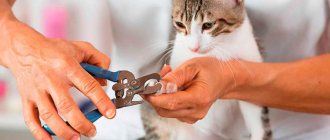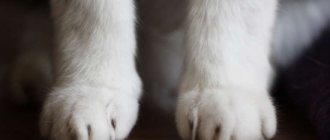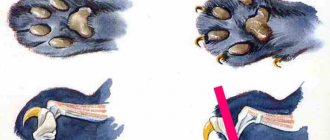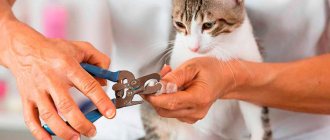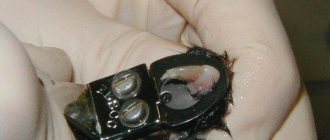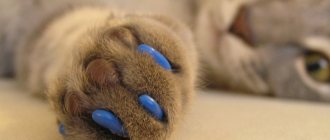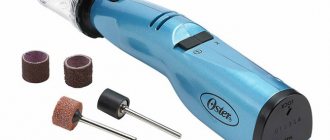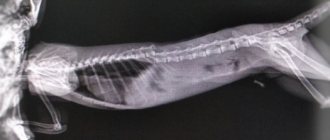Price for “soft paws” surgery for cats at the vet:
| Service | Price, rub |
| Onchyectomy (“soft paws”) on 2 paws | 6000 |
| Onchyectomy (“soft paws”) 1 claw | 700 |
| Anesthesia for a cat during onchyectomy | from 500 |
“ Soft paws for cats , there are scratches on the paws...” In the daily life of their pets, owners of domestic cats are faced with many acute problems that have to be solved one way or another. The fluffy purr needs not only to be fed and treated, but also raised, accustomed to life in an apartment and in a family. Some skills are acquired without problems, while others remain a subject for constant battles. For many owners, the real test was the sharp claws of their pets. Which they grind off on everything, or when playing, leave painful scratches on children and adults. New furniture, new wallpaper can become a new victim for growing claws. And any animal, even the most peace-loving one, is not immune from attacks of aggression or the desire to dig its claws deeper while playing with you or a child.
What to do? Often people are faced with a choice: give the animal away, let it go outside, even euthanize it, or undergo surgery - soft paws for cats. Before you run to the veterinary clinic so that your kitten’s paws become like soft pillows, explain to yourself all the nuances of this surgical intervention, its consequences for cats and the peculiarities of life for pets after surgery.
What is Soft Paws for Cats surgery?
When all the means to re-educate a cat have been tried and the question arises, the owner of the animal thinks about where the declawing procedure can be done and what its consequences .
Let's start with the fact that any surgical intervention carries with it
certain risk:
- Some animals have difficulty recovering from anesthesia
- After the operation, any complications may develop.
Onchyectomy ( claw amputation ) is the removal of the ungual, distal phalanx . There is a second version of this operation, when the tendon of the flexor muscle of the finger is removed , and because of this the claw remains in its bed, the cat cannot “release” the claws.
During this operation, only the claw phalanx is removed. When the limited access method is used, self-absorbing sutures are applied, this allows the wounds to heal quickly, and the animal, especially the kitten, quickly adapts and lives a normal active life.
Indications for surgery soft paws for cats
The soft paw operation has relative indications for use, since no one can call this intervention necessary for health reasons. But still, the aggressive behavior of the animal and the ineffectiveness of using alternative means forces the owner to resort to this last resort. Cases are described when an animal, in a fit of anger, or playfully, scratched the face of a child, and attacked the owner at night. Ordinary scratches in weakened people, the elderly and children can cause a complication - felinosis . This infectious disease, caused by bacteria of the genus Bartonella, is characterized by fever, swollen lymph nodes, and in severe cases, conjunctivitis, damage to the nervous system, enlarged liver and spleen, and blood poisoning. Every cat scratch must be disinfected !
Contraindication to amputation of claws in cats
A contraindication to amputation of claws in cats is the cat’s free stay at home and on the street, since it is deprived of the opportunity to stand up for itself in the event of an attack, climb a tree, catch its claws when falling, etc. By deciding on this operation, you take responsibility for life and safety defenseless creature.
Although it should be recognized that owners who have become attached to their pets already feel their duty to them and strive to make their life as comfortable as possible with their family.
What to do instead of surgery
Veterinarians and zoologists have long understood the problem and found solutions that can help avoid surgery and keep the interior intact. To protect yourself from scratching, you can use safe methods designed for cats:
- Trimming the dead sharp tips of the claws. This will reduce the need to regularly sharpen the claws on all accessible surfaces.
- Silicone stickers on claws. They are attached with special glue like false nails. Protect the owner from injury. But the animal does not lose the ability to slow down in a jump and secrete a secret to mark its territory.
- Training to use a scratching post. Sometimes a cat just needs to sharpen its claws for peace of mind. Such is the nature of a cat. Just show your pet where it can be done: the same way you trained it to use the tray.
All methods are painless and harmless to the cat and do not cause discomfort. If you spend a little more time on your animal, you can easily do without a mutilating and dangerous operation.
Veterinary doctors do not perform onychectomy or soft paw surgery. But if your cat scratches, contact us for a consultation. We will find the cause of the problem and help you fix it.
How is the operation soft paws for cats performed?
If you have made a conscious decision to have a soft paw surgical procedure, it is important to find a good veterinarian who will competently and skillfully perform this operation. It is usually performed under general anesthesia. No one “rips out” the claws, the doctor carefully removes them using special tools, the pillows are not injured, sutures are placed on the incisions, it is better if they are absorbable. The paws are bandaged to protect them from bleeding. Additional medications may be prescribed to help the cat recover better from anesthesia.
Post-operative cat care
Usually after 6-10 hours
The cat can already move independently.
It is recommended to keep an eye
on her for at least
a day or two until she completely recovers from anesthesia; this time is individual for each animal.
Veterinarians recommend providing the animal with a comfortable bed on the floor, limiting walking and jumping in the first hours after surgery, and not allowing jumping from a height. Day or two after surgery
The paws may bleed and the cat will feel uncomfortable stepping on them, but within 10-12 days everything should return to normal and the cat will continue to run, play and jump on cabinets.
Surgery and aftercare
Declaw removal can be done both in the clinic and at home. The procedure is not technically difficult, so it does not require special preparation (except for fasting for several hours).
Before the operation, the surgeon conducts a full clinical examination of the patient; if no signs of disease are detected, he prepares him for the manipulation itself.
The animal is given premedication (for a smooth introduction to anesthesia), then a drug that ensures a complete shutdown of consciousness, so during declawing, the cat does not feel anything. A small incision is made on each toe of the front paws, through which the claw and phalanx containing the claw bed are removed.
Several skin sutures are placed on the wound, after which it is treated with an antibacterial agent. The surgeon must remain with the patient until the animal begins to recover from anesthesia.
After a few hours, the cat finally comes to her senses and leads a normal life. To prevent the development of infection, increased hygiene measures should be taken (keep the animal's floor and tray clean).
It is also necessary to strictly follow the doctor’s recommendations; only in this case can the veterinarian guarantee the absence of complications. During the first 5-7 days there is slight lameness, causing the pet some discomfort, which does not require human intervention and goes away on its own.
Possible complications after surgery soft paws for cats
On the Internet you can find a lot of “horror stories” about onchyectomy. The opinion is expressed that the animal becomes disabled with a broken psyche, its character changes for the worse. Cats move worse, the harmony of the musculoskeletal system is disrupted. But a cat's claws are not used when walking and supporting themselves.
, since it rests on the first and second phalanges of the fingers, and the last claw phalanx remains retracted.
Claws are needed only for hunting and protection from enemies .
Complications after this operation , a description of which can be found on the Internet, occur as a result of poor quality performance: a fragment of the distal phalanx is left, non-absorbable threads are used for sutures, and aseptic conditions are violated.
Myths and truth about the consequences after surgery: soft paws for cats
There are also cases described when a cat becomes cowardly, aggressive, and unkind due to the “soft paws” procedure. Most people who agree to this operation for their pets do not notice such negative changes in the cat’s character; its gait, coordination and behavior do not change.
The essence of the operation
When performing an onychectomy, or the so-called “soft paws” procedure, the front paws are subjected to surgical intervention, and bone tissue and tendons are also removed. It is done under general anesthesia with a scalpel. Duration – 40 minutes. In this case, blood loss occurs. After amputation, stitches are applied, then a multi-layer bandage. If desired, onychectomy is done along with castration, but this can lead to disability of the pet.
Animal advocates are against this procedure because it is very painful for cats. In Russia, not all clinics provide this service without medical indications.
Its price ranges from 1.5 to 6 thousand rubles. If done at home, it will be more expensive.
Soft paws for cats - conclusion
Of course, it is up to you to decide whether your pet needs to be declawed. Often, owners try more gentle methods of exposure - repellent sprays, various scratching posts, claw trimming, silicone pads. And only after making sure of their low effectiveness do they resort to this procedure. After weighing all the pros and cons, do not blame yourself if the cat puts out its claws in places and places out of place, but seek qualified veterinary help. Not all veterinary clinics perform this operation, but if it is included in the list of services, ask how it will be performed, what materials will be used, whether the veterinarian supervises the patient’s recovery from anesthesia and other questions that interest you.
At the veterinary clinic, our surgeons will be happy to talk to you and answer all your “painful questions.” A consultation with a doctor by phone is free of charge; also, if it is impossible to deliver the cat to the clinic (and they may be very aggressive or simply scared), simply fill out a request for a veterinarian to come to your home. You can find out about all services and prices for them by calling our phone. Remember that only you are responsible for the life and health of your furry household, as well as for the safety and peace of mind of other members of your family!
Indications and contraindications
The main reasons for onychectomy:
- Mechanical or disease-induced damage to the claw phalanx.
- Ingrown nail.
- Purulent inflammation, advanced fungal infections;
- Uncontrollable animal aggression;
- Epilepsy.
- Neoplasms in tissues;
- Host diseases, blood clotting disorders.
Contraindications are the cat's free access to the street. Without sharp claws, she will not be able to protect herself from other animals, climb a tree or fence, or stop herself from falling.
To perform an onychectomy, the cat must be at least 7 months old.
Alternative solutions
This is a very cruel procedure for the animal. There are other methods to prevent your cat from scratching:
- Trim the claws with pliers with rounded ends, only the tip is 2-3 mm, once a month.
- Attachments are applied to the claws using special glue or “anti-scratch.” They come in silicone, plastic, and rubber. The disadvantages are that the animal does not immediately get used to such “claws”; they complicate the cat’s proper hygiene.
- They accustom the pet to the scratching post; it is better to do this as soon as the kitten appears in the house, to encourage it. They are sold in different shapes and sizes. Also read about how to make a scratching post yourself using available materials.
- They buy different toys for the kitten and train the pet from childhood.
- Purchase special animal repellers for furniture. They are sold in the form of sprays. They are used to treat walls and upholstery. You can do it yourself: it is believed that pets do not like the smell of perfumes, essential oils, especially fragrant rue, and spices.
There is another alternative - tendonectomy. This is a surgical procedure to cut out a small section of the tendon, after which the cat is unable to extend its claws. It is considered less dangerous, but can also lead to complications.
1111
Mr. Cat warns: complications of onychectomy
The advantages of this method of declawing are that the animal will not damage expensive furniture, wallpaper, curtains and other property and will not scratch the owner and his family members. However, the operation implies a high risk of complications for the cat’s health:
- Allergy to anesthesia, which can lead to the death of the pet.
- Yellow discharge from the wound, which may be the result of infection.
- Blood poisoning.
- Decreased immunity.
- Impaired movement coordination.
- Changes in posture, curvature of the spine.
- Loss of dexterity, decreased balance.
- Pain when walking due to a damaged nerve.
- Weakening of the back muscles.
- Dysbacteriosis due to prescribed antibiotics.
- Formation of calluses behind the pads.
- Hypersensitivity, in which it is very painful for the animal to get up.
You should constantly examine the cat’s paws, monitor whether lameness has appeared, and if complications are detected, immediately contact a veterinary clinic.
The disadvantages are that the animal’s psyche is traumatized, the cat stops playing as before, becomes fearful, withdrawn, and aggressive. Those pets that have not been neutered often “mark their territory.” In European countries, such an operation is illegal, but in America it is widely used.
